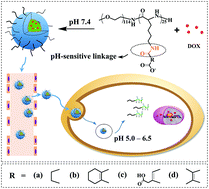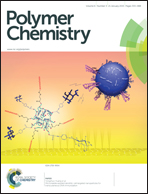Polyion complex micelles with gradient pH-sensitivity for adjustable intracellular drug delivery†
Abstract
A series of poly(amino acid)-containing copolymers with gradient pH-sensitive side groups were synthesized through ring-opening reaction of succinic anhydride (SA), cis-cyclohexene-1,2-dicarboxylic anhydride (CDA), cis-aconitic anhydride (CA), and dimethylmaleic anhydride (DMMA) initiated by the amino groups in methoxy poly(ethylene glycol)-block-poly(L-lysine). Subsequently, four pH-responsive polyion complex (PIC) micelles (denoted as SAD, CDAD, CAD and DMMAD) were prepared through the electrostatic interaction between pH-responsive negatively charged copolymers and positively charged doxorubicin for adjustable intracellular drug delivery. Due to the differences among the acid-sensitive side amide bonds, these micelles were proved to have gradient pH-sensitivity in the following order: SAD < CDAD < CAD < DMMAD. The in vitro drug release rate was consistent with the sensitivity order of the micelles. The intracellular DOX release behaviors and cytotoxicities of the PIC micelles could also be adjusted by the sensitivities of copolymers. All these different characters among the PIC micelles would be further applied for “on demand” intracellular targeting chemotherapy in clinics.



 Please wait while we load your content...
Please wait while we load your content...